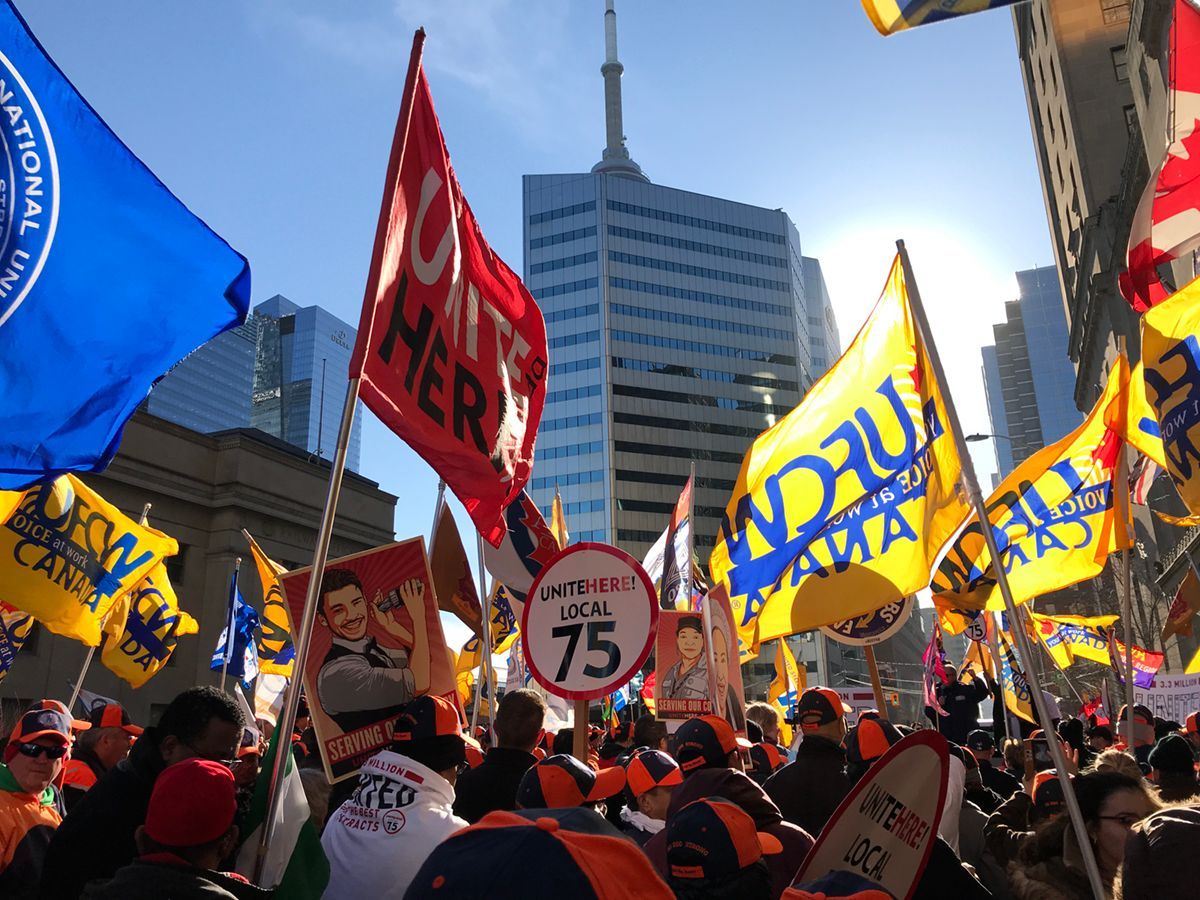There’s the story of the guy who went to the gas station to pump up his car tires… they charged him 50 cents. He said, “it was only 20 cents last week.” The attendant replied, “that’s inflation for you.”
Except inflation is no joke. When certain phrases get constantly used, they can lose their meaning. Take one that is often bracketed with inflation: “Cost of Living Crisis.” As the words say, the cost of being able to live is too high. Due to inflation, the very idea of living or survival is called into question. Can workers afford a system with prices rising so much it calls into questions the potential just to be alive? In a rich country like Canada, that may sound melodramatic but the increased use of food banks between 2019 to 2021, up 20.3 percent, demonstrates the reality for many people. Statistics Canada reported that Canadians paid 9.7 percent more for food in May 2022 than a year prior, while average hourly wages rose by about 5.2 percent year-over-year. Basic foods like fresh fruit have jumped by 10.3 percent, while edible fats and oils prices spiked by nearly 30 percent. Average consumer prices increased 7.7 percent over the past year — the fastest in more than 30 years. Prices are rising much faster than wages. And workers are being blamed.
On July 13, the Bank of Canada added to the economic misery, jacking up interest rates from 1.5 percent to 2.5 percent, an increase of 66.7 percent! This will increase the cost of living for everyone with any debts, most Canadians. Mortgages will go up and rent rises are more likely. This in the name of fighting inflation.
What causes inflation?
Most economics taught in school claims there are two types of inflation. The first is “cost-push” inflation, where an increase in the cost of production, say, from a rise in the international price of oil, pushes prices up. The second is “demand-pull” inflation, or the increase in aggregate demand, generally attributed to workers having more disposable income from wage increases while output remains the same. In both cases, workers get the blame — one, as a major factor in the cost of production and two, for being consumers who go out and spend their wages or savings.
The only neutral thing you can say about inflation is that it is the rate at which the general price level of goods and services rises. This, in turn, causes a drop in purchasing power. If wage increases were responsible for inflation, you would expect increases in the minimum wage to result in higher prices. Not so. In 2016, researchers from the Upjohn Institute for Employment Research examined the effect of prices on minimum wage increases in various states in the US from 1978 through 2015. They found that “By looking at changes in restaurant food pricing during the period of 1978–2015 … prices rose by just 0.36 percent for every 10 percent increase in the minimum wage. They also observe that small minimum wage increases do not lead to higher prices and may actually reduce prices. Furthermore, it is also possible that small minimum wage increases could lead to increased employment in low-wage labor markets.”
Jim Stanford, former economist with the union Unifor, pointed out in a recent Toronto Star article that “public sector workers face draconian pay caps that amplify the losses from inflation. For example, 270,000 public sector workers in Ontario have had pay raises capped at one percent by the Ford government since 2019. As compensation for their bravery and dedication during the pandemic, their real wages will be cut 5.5 percent this year alone. The federal government is being slightly more generous by offering its staff an average 1.7 percent per year over four years.”
The current inflation has not been caused by workers. Prices have been surging ahead of wages since mid-2020, and workers’ share of GDP is shrinking as a result. The more obvious explanations for this inflation are supply chain disruptions (affecting 9 out of 10 Canadian manufacturers), the housing bubble, and the energy price shock following Russia’s invasion of Ukraine.
Private businesses are reaping bigger profits as consumers pay higher prices. Wholesale margins have grown more than twice as fast as overall inflation, and pre-tax corporate profits, this year, have reached their largest share of revenues in over a decade as inflation took off. Stanford notes: “It’s clear the current situation is a case of profit-price inflation, not wage-price inflation. Suppressing wages doesn’t address the cause of the problem, and will have no value curing it.”
Stanford makes the point: “even if inflation subsides, what will happen to workers’ wages in the meantime? If wages aren’t lifted, and quickly, workers will experience a permanent reduction in their living standards as a legacy of inflation they didn’t cause — but which enriched others (from petroleum giants to housing developers to grocery chains).”
Monetary policy
Monetary policy is the attempt to control the quantity of money available in an economy and the channels by which new money is supplied. By managing the money supply, a central bank aims to influence factors including inflation, the rate of consumption, economic growth, and overall liquidity. In response to COVID and the recession it triggered governments and central banks pumped large sums of money into the economy. Much of it went into the pockets of big business and the rich or into asset bubbles — stock market, cryptocurrencies, etc., but some fed the housing bubble and went into the wider economy.
Now central banks are pushing up interest rates, claiming that it will slow inflation. However, as the Marxist economist, Michael Roberts, has pointed out: “If rising inflation is being driven by a weak supply-side rather than an excessively strong demand side, monetary policy won’t work.” Monetary policy supposedly operates through the use of the central bank’s lending rate to raise or lower “aggregate demand.” If spending is moving too fast for production to meet it and so generating inflation, higher interest rates supposedly dampen the willingness of companies and households to consume or invest by increasing the cost of borrowing. Roberts notes, “But even if this theory were correct (and the evidence does not support it much), it does not apply when prices are rising owing to supply chains being broken, energy prices are increasing or there are labour shortages.” Robert quotes Andrew Bailey, governor of the Bank of England, “Monetary policy will not increase the supply of semiconductor chips, nor will it produce more HGV (truck) drivers.” One could add that neither will depressing wages deal with these issues.
The Bank of Canada, in its April statement announcing an interest hike, stated that growth was strong and that the economy was moving into excess demand. Labour markets have become “tight,” and wage growth has got to its pre-pandemic pace and was rising. Businesses have increasingly reported they are having difficulty meeting demand but are able to pass on higher input costs by increasing prices. Well, that’s great for some businesses but it doesn’t help a public service worker in Ontario who has to get by with the maximum one percent increase imposed by the government.
The way pushing up interest deals with inflation is it leads to a recession, with major job losses — in Canada probably over 750,000 workers. The Bank of Canada claims it is aiming for a “soft landing,” a slowdown of the economy without a recession. As a CCPA study shows, the Bank has never achieved this dream. The frightening past example of using high interest rates to tackle inflation was at the end of the 1970s and early 1980s. Interest rates were over 20 percent in the US and Canada and close to 20 percent in other countries. The outcome was a deep worldwide recession, with Canada in 1983 suffering the worst unemployment since the 1930s.
Workers need pay increase
Alarmingly for union members, although overall wages rose by 5.2 percent in June, wages for workers with union contracts only had a 3.7 percent increase, while non-union workers gained 6.1 percent.
Canadian unions need to respond with determined action to defend living standards. Unions should be pressing to reopen multi-year contracts to increase pay in line with inflation. New contracts must cover the threat of inflation.
Vitally, workers need a return to the militant traditions of Canadian labour such as the Ford Windsor strike of 1945 or the Québec Common Front strike of 1972. In the latter case, over 200,000 public workers walked off the job in a province-wide general strike to demand an 8 percent raise to match inflation, a $100-per-week minimum wage, better job security and working conditions, and equal pay for equal work. In addition to these demands, Cost-of-Living Adjustments (COLA) are another measure that will address the rising cost of living.
COLA — the Italian story
COLA can soften the impact of inflation on workers when unions win them as a part of the union’s collective agreement. COLA is an increase in wages to counteract inflation, with pay automatically increased in line with the increase in the cost of living, so workers’ living standards are not eroded by inflation.
COLA clauses were negotiated by Canadian and US unions in the mid 1970s as inflation soared to a high of 15 percent, with sky high interest rates peaking at 21 per cent in August 1981. COLA owes its origins to La Scala Mobile (“moving staircase”) introduced in Italy in 1945 during a period of political radicalization when Communists were in the government. Unlike the Canadian agreements of the 1970s, it was not something negotiated between individual unions and employers. Rather, it was negotiated and overseen on a tripartite level — the national trade union federations, the national employers’ federation and the government. The Italian capitalists were never happy with La Scala, but the workers loved it. By the early 1980s it was estimated that La Scala accounted for over 60 per cent of annual wage increases. Italy was no exception, among advanced economies in the 1970s and 1980s, in experiencing the rise of globalization and neoliberalism. The Italian working class was also no exception in suffering attacks from the employing class, so it was no surprise that the employers launched a concerted attack on La Scala resulting in its demise in 1993.
Cost of Living Adjustments — the Canadian story
According to a 2015 report by Statistics Canada, the share of agreements that are settled with COLA annually has been declining steadily since the early 1990s. The proportion of employees covered by a COLA clause has been declining as well. In the late 1970s nearly half of all workers were covered by COLA agreements. A recent Toronto Star article points out that by 2014 only one percent of all unionized workers were covered by COLA.
In the federal jurisdiction, the decline in the share of settlements with COLA has been relatively mild, compared to other jurisdictions. Among the major sectors, the proportion of employees covered by COLA has sharply declined in public administration, education, health and social services. However, the decline has been more moderate in manufacturing and transportation. Employees covered by COLA did not consistently have any substantial advantages over those without COLA and any wage disparity between the two groups had disappeared by 2007. Over the last two decades, as inflation remained low and stable, more than half of the COLA agreements never come into effect. Unlike the Italian La Scala Mobile, where cost of living increases — no matter how small — kicked in automatically, most of those in Canada were only triggered when inflation reached a certain point.
The lesson to be learned from this — COLA should be triggered automatically, no matter the rate of inflation shown by the CPI. COLA should also apply to pensioners, welfare recipients and anyone else living on a fixed income. While the Canadian pension plans are indexed, most provincial income payments (like welfare and disability payments) are not.
Charting a new course for labour
Rather than rely on jacking up interest rates, with the likely outcome of a recession and high unemployment, government can take action to tackle inflation. They can fix supply chains, sharply reduce energy prices, and bring in rent controls on housing. Governments could act to directly bring down prices including for childcare; health, dental, and drug costs; and transit fares. Some government measures to dampen spending would actually be welcome such as windfall taxes on the big oil companies and increased taxes on the rich, which would have the effect of recycling revenues to enhance social benefits. Together, these would significantly tame inflation. Having COLAs in place would also maintain the purchasing value of wages, without prompting higher inflation. However, such a program requires a government that is willing to challenge big business and its endless drive for more profits.
Workers didn’t cause this inflation. And they shouldn’t have to pay for it. Irrespective of what governments and central banks are doing, labour should be charting its own course — demanding the reopening of collective agreements to add COLA clauses and demanding substantial wage increases to catch up for what has been lost over the past period. The recent settlement of a transit strike in BC included a COLA. The demand for a COLA is part of the current negotiations of some BC government employees in BCGEU. This struggle should be supported by all workers and the demand should spread across all unions.
Furthermore, the case for socialism is more than confirmed by this analysis of the workings of the capitalist economy. The task of building a workers’ party with a socialist program becomes more urgent.




